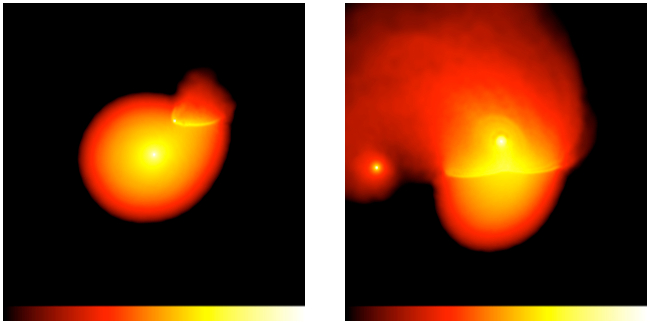Red-giant destruction in the galactic nucleus
The galactic centre contains a high number density of stars orbiting around a central, massive black hole (about three million times the mass of the sun). In such a crowded environment, collisions between stars occur relatively frequently. Collisions between two main-sequence stars (like the sun) may result in their merger and thus the production of a single, more-massive main-sequence star. Collisions are more likely to occur to a star on the so-called red-giant branch, as here the stars are larger and thus pose a large target for other stars to hit. Collisions between red giants and other stars will result in the loss of the some fraction of the gaseous envelope of the red giant.
Red-giant stars are bright, and therefore relatively easy to see, even in the galactic centre. The vast majority of red giants seen have masses between 1 to 4 solar masses. Surveys have revealed a depletion of red giants in the very centre. In other words, the actual number of red giants present in the very centre is much less than one would have expected by extrapolation of the population seen further out: some process appears to be destroying or removing red giants in the very centre of our Galaxy. The central regions of our Galaxy contain a very high number density of stars, hence it is natural to suggest that stellar collisions may provide the answer. In earlier work, we showed that collisions between red giants and normal, main-sequence stars could not in fact destroy them. Even if such collisions removed half of the red-giant's gaseous envelope, what remained of the envelope would quickly puff up such that that it would appear as a normal red giant.
Collisions between red giants and stellar-mass black holes (masses of about ten solar masses) will be more damaging to red giants than collisions involving lower-mass main-sequence stars and white dwarfs. We have performed a series of simulations of collisions between stellar-mass black holes and low-mass red giants using the so-called SPH method. We have focussed on lower-mass stars (1 to 4 solar masses) as the vast majority of the visible red-giant population will come from this range of masses. Snap shots of a typical run are shown below. In this collision a 10 solar mass black hole has hit a 1 solar mass red giant (black hole travelling from right to left in the figure) passing within a minimum distance of 10 solar radii (corresponding to approximately half the red-giant radius). The collision has an extreme effect on the red giant. Some 80% of the envelope is removed, some of which remains bound around the black hole. What remains of the red giant would no longer be visible to us as a bright red giant in the galactic centre. Thus collisions involving stellar-mass black holes could indeed be responsible for the observed depletion of red giants in the galactic centre.
IMAGE 2:
Density slices taken through the z=0 plane as a black hole impacts a red giant.
